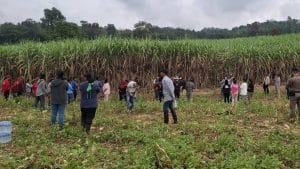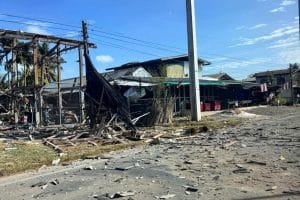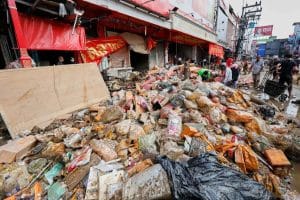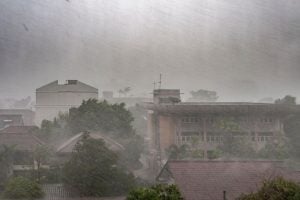Afghanistan: Can Taliban avert food crisis without foreign aid?

More than half the population of Afghanistan will face high levels of “acute food insecurity” from November to March, according to a recent report from the UN’s Food and Agriculture Organization (FAO) and the World Food Program (WFP).
The report said the acute food insecurity is expected to last through the post-harvest “lean season,” during which harsh winter weather threatens to “cut off areas of the country where families desperately depend on humanitarian assistance to survive the freezing winter months.”
According to the FAO and WFP, 23 million Afghans — including 3.2 million children under the age of five — are currently suffering from hunger. They urgently need food, drinking water, medical care and decent shelter in winter.
“Afghanistan is now among the world’s worst humanitarian crises … and food security has all but collapsed,” said David Beasley, WFP executive director.
“This winter, millions of Afghans will be forced to choose between migration and starvation unless we can step up our life-saving assistance, and unless the economy can be resuscitated,” Beasly said in a press release.
“Hardly anyone has money in Afghanistan right now,” Hamidullah Khadem, head of the Chamber of Industry in Herat province, told DW.
“In the industrial area of Herat alone, 70% of the companies have gone out of business. There is no demand. Purchasing power has shrunk extremely. Civil servants and employees in the public sector hardly get paid,” he added.
Drought combined with government collapse
This winter would have likely been difficult for Afghans with or without the Taliban having seized power in August.
Afghanistan experienced its second drought in four years in 2021, having a severe impact on agriculture and livestock.
This would have been enough on its own to trigger a humanitarian emergency. The Taliban’s return to power and the resulting flight, displacement and withdrawal of foreign aid agencies has only exacerbated the situation.
Smaller businesses such as silk manufacturers or brickworks currently have little chance of survival. The number of unemployed in Afghanistan increases daily, and with it the number of those who can no longer afford food.
“Many of my acquaintances and friends are selling their furniture and kitchen appliances like their refrigerator to be able to buy something to eat,” said a female activist who asked not to be named. “Those who can leave the country are making their way.”
The security situation in Afghanistan under the Taliban has also deteriorated along with the economy. There are more and more reports of kidnapping and hostage taking of businessmen and those with money.
Kabul-based economic expert Khanjan Alokozay told DW that in the last two months, more than 40 shopkeepers and businessmen were kidnapped in different parts of the country and some of them were also killed.
The Taliban know that many Afghans want to take their money and belongings and flee Afghanistan. To prevent this, Afghans are currently only allowed to withdraw the equivalent of $200 (€175) per week.
An economy dependent on foreign aid
Afghanistan’s economy will shrink by up to 30% this year, according to the International Monetary Fund (IMF).
Afghanistan’s GDP in 2020 was only around $20 billion. And according to the World Bank, 43% of that was based on aid money from abroad. Before the Taliban takeover, 75% of public spending came from foreign aid grants.
That foreign funding was stopped after the Taliban came to power in August. In addition, most of Afghanistan’s foreign currency reserves were frozen abroad.
Although the UN said it secured €1 billion in humanitarian aid pledgesfor Afghanistan to prevent a crisis, it remains a challenge for donors to make sure the funding is channeled through aid agencies on the ground so it reaches those in need.
For example, Germany is providing €600 million in humanitarian assistance, €90 million of which is going to the WFP.
However, the WFP said in a press release that current funding is a “drop in the ocean” to meet the food and nutrition needs in Afghanistan. To meet the task at hand, the WFP said it may require as much as $220 million per month.
And international donors continue to be wary that aid money will end up in the Taliban’s coffers, and providing aid on the ground necessitates engaging with the Taliban on some level.
The World Bank recently said it does not expect to continue direct development aid payments to Afghanistan as the economy has collapsed, and there is no way to ensure where the money will end up.
Growing poppies instead of wheat
“To fight against our problems, we need access to our frozen assets abroad and also the possibility to participate in the international payment system,” Mohammad Younis Mohmand, the head of Afghanistan’s trade and investment chamber, told DW.
Mohmand emphasized that the Taliban would then be able to prevent the collapse of the economy and alleviate the suffering of the people.
The Taliban would plan an emergency program to reduce the number of unemployed and reduce hunger in the country.
Taliban government spokesman Zabiullah Mujahid announced that thousands of unemployed people would participate in an employment scheme in return for receiving wheat. For example, participants would dig canals and basins during the winter to prevent future droughts.
However, it is unclear where the Taliban will get the wheat. The ousted government had announced in July that the drought means Afghanistan would have to import one-third of its annual wheat requirements.
Wheat is considered the staple food in Afghanistan. However, many Afghan farmers prefer to grow poppies for more lucrative opium production instead of wheat.
The drug trade has become one of Afghanistan’s most important industries. Three of the past four years have each seen record levels of opium production in Afghanistan, according to the United Nations Office on Drugs and Crime (UNODC).
Even as the coronavirus pandemic raged last year, poppy cultivation in Afghanistan increased by 37%, the report said.
SOURCE: DW News
Latest Thailand News
Follow The Thaiger on Google News:


























